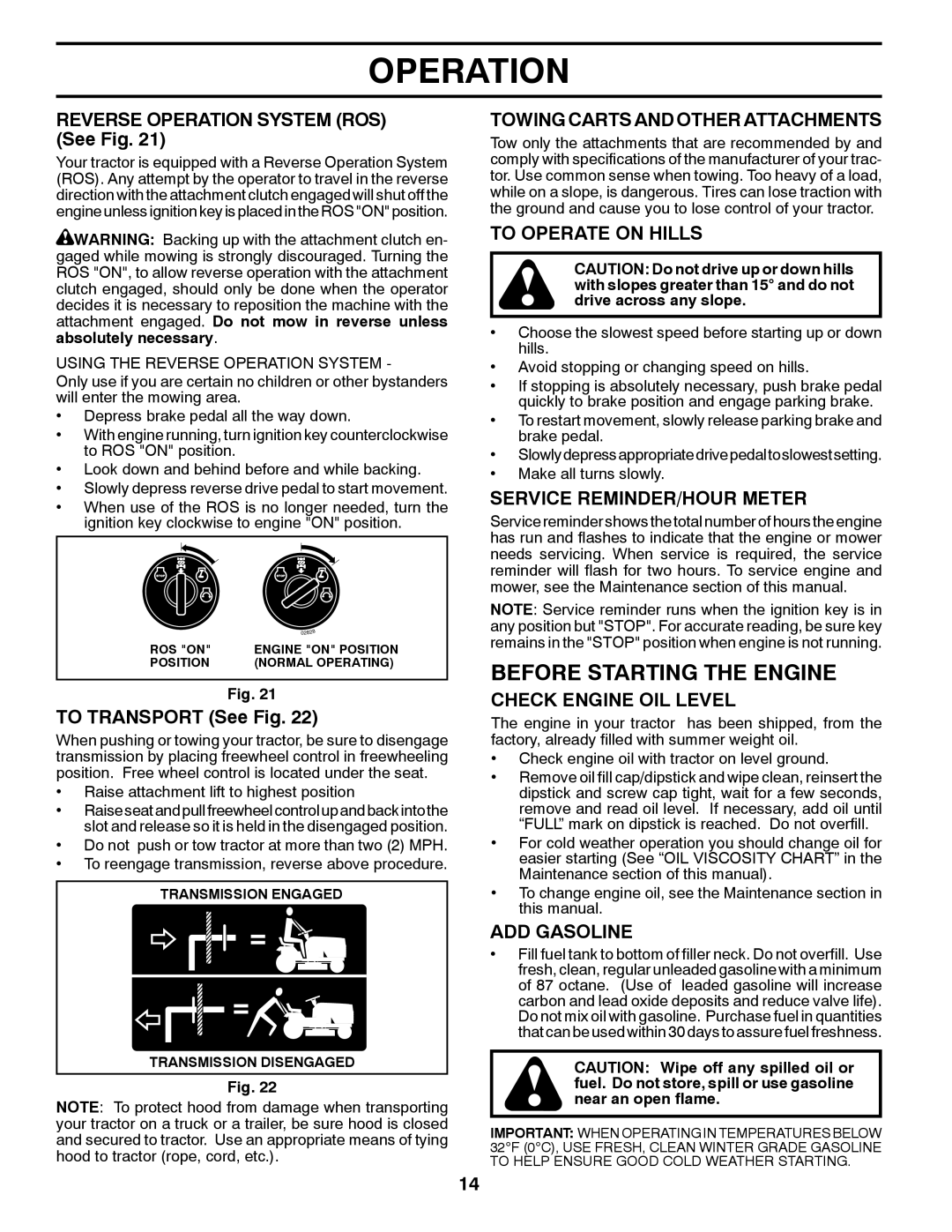
OPERATION
REVERSE OPERATION SYSTEM (ROS) (See Fig. 21)
Your tractor is equipped with a Reverse Operation System (ROS). Any attempt by the operator to travel in the reverse direction with the attachment clutch engaged will shut off the engine unless ignition key is placed in the ROS "ON" position.
![]() WARNING: Backing up with the attachment clutch en- gaged while mowing is strongly discouraged. Turning the ROS "ON", to allow reverse operation with the attachment clutch engaged, should only be done when the operator decides it is necessary to reposition the machine with the attachment engaged. Do not mow in reverse unless
WARNING: Backing up with the attachment clutch en- gaged while mowing is strongly discouraged. Turning the ROS "ON", to allow reverse operation with the attachment clutch engaged, should only be done when the operator decides it is necessary to reposition the machine with the attachment engaged. Do not mow in reverse unless
absolutely necessary.
USING THE REVERSE OPERATION SYSTEM -
Only use if you are certain no children or other bystanders will enter the mowing area.
•Depress brake pedal all the way down.
•With engine running, turn ignition key counterclockwise to ROS "ON" position.
•Look down and behind before and while backing.
•Slowly depress reverse drive pedal to start movement.
•When use of the ROS is no longer needed, turn the ignition key clockwise to engine "ON" position.
| 02828 |
ROS "ON" | ENGINE "ON" POSITION |
POSITION | (NORMAL OPERATING) |
Fig. 21
TO TRANSPORT (See Fig. 22)
When pushing or towing your tractor, be sure to disengage transmission by placing freewheel control in freewheeling position. Free wheel control is located under the seat.
•Raise attachment lift to highest position
•Raiseseatandpullfreewheelcontrolupandbackintothe slot and release so it is held in the disengaged position.
•Do not push or tow tractor at more than two (2) MPH.
•To reengage transmission, reverse above procedure.
TRANSMISSION ENGAGED
TRANSMISSION DISENGAGED
Fig. 22
NOTE: To protect hood from damage when transporting your tractor on a truck or a trailer, be sure hood is closed and secured to tractor. Use an appropriate means of tying hood to tractor (rope, cord, etc.).
TOWING CARTS AND OTHER ATTACHMENTS
Tow only the attachments that are recommended by and comply with specifications of the manufacturer of your trac- tor. Use common sense when towing. Too heavy of a load, while on a slope, is dangerous. Tires can lose traction with the ground and cause you to lose control of your tractor.
TO OPERATE ON HILLS
CAUTION: Do not drive up or down hills with slopes greater than 15° and do not drive across any slope.
•Choose the slowest speed before starting up or down hills.
•Avoid stopping or changing speed on hills.
•If stopping is absolutely necessary, push brake pedal quickly to brake position and engage parking brake.
•To restart movement, slowly release parking brake and brake pedal.
•Slowlydepressappropriatedrivepedaltoslowestsetting.
•Make all turns slowly.
SERVICE REMINDER/HOUR METER
Service reminder shows the total number of hours the engine has run and flashes to indicate that the engine or mower needs servicing. When service is required, the service reminder will flash for two hours. To service engine and mower, see the Maintenance section of this manual.
NOTE: Service reminder runs when the ignition key is in any position but "STOP". For accurate reading, be sure key remains in the "STOP" position when engine is not running.
BEFORE STARTING THE ENGINE
CHECK ENGINE OIL LEVEL
The engine in your tractor has been shipped, from the factory, already filled with summer weight oil.
•Check engine oil with tractor on level ground.
•Remove oil fill cap/dipstick and wipe clean, reinsert the dipstick and screw cap tight, wait for a few seconds, remove and read oil level. If necessary, add oil until “FULL” mark on dipstick is reached. Do not overfill.
•For cold weather operation you should change oil for easier starting (See “OIL VISCOSITY CHART” in the Maintenance section of this manual).
•To change engine oil, see the Maintenance section in this manual.
ADD GASOLINE
•Fill fuel tank to bottom of filler neck. Do not overfill. Use fresh, clean, regular unleaded gasoline with a minimum of 87 octane. (Use of leaded gasoline will increase carbon and lead oxide deposits and reduce valve life). Do not mix oil with gasoline. Purchase fuel in quantities that can be used within 30 days to assure fuel freshness.
CAUTION: Wipe off any spilled oil or fuel. Do not store, spill or use gasoline near an open flame.
IMPORTANT: WHEN OPERATING IN TEMPERATURES BELOW 32°F (0°C), USE FRESH, CLEAN WINTER GRADE GASOLINE TO HELP ENSURE GOOD COLD WEATHER STARTING.
14
